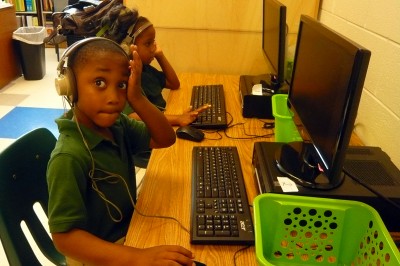 School districts from the sprawling Los Angeles Unified to the tiny Nome Public Schools in Alaska have embraced technology in the classroom based on the promise that it can improve learning by increasing student engagement.
School districts from the sprawling Los Angeles Unified to the tiny Nome Public Schools in Alaska have embraced technology in the classroom based on the promise that it can improve learning by increasing student engagement.
A game which allows students to use a virtual scalpel to prod and poke muscles and blood vessels in the human body, for instance, is likely to be more attractive to a ninth grade biology class than an anatomy lecture.
Couple such a game with an instant feedback mechanism that provides real-time data on the student’s performance and that’s further enticement to schools to bring more devices into the classroom. Proponents of such individualized instruction say the technology allows teachers to assess how their students are doing in class more accurately, showing teachers how to help students in a more targeted fashion.
But is expanding access to iPad, laptop, and smart phone screens in school taking away from human interaction between teachers and students? And does it actually lead to more learning?
We don’t know the answer to these questions just yet. Greg Anrig, author of Beyond the Education Wars: Evidence That Collaboration Builds Effective Schoolspublished last spring, says there is currently little research on the impact increased technology use may have on the teacher-student relationship. But he asserts that effective use of technology depends on good human relationships.
In the book, Anrig cites a study that found two or more students working together and sharing one computer learned more than an individual student working on a computer alone. Other research shows that technology can help improve student achievement but only in conjunction with other factors including effective teacher development, better modeling by teachers and student collaboration when using these devices.
“We don’t know yet in a lot of ways what some of these new devices will be able to do with the learning process but it’s definitely a concern if the idea is…that they’ll take over for what teachers can do,” said Anrig, who is also vice president of policy and programs at The Century Foundation, an independent progressive think-tank. “The question is are teachers going to be integrating them into what they’re already doing ideally in ways that are creating more effective interactions rather than substituting for them?”
What concerns him most in the promotion of education technology is the assumption that just handing kids new devices will be sufficient for them to make gains in learning, when there is no research showing this to be the case. Jack Schneider, an assistant professor of education at the College of the Holy Cross in Massachusetts, agrees.
“Look at the disaster in L.A. schools right now — they purchased 600,000 iPads and are having all kinds of problems,” he said in an email, referring to students who learned to bypass the security system on the districts’ iPads in order to access restricted sites. The iPads have now been taken away from some school campuses.
“Relationships are what matter in schools. Any deep exploration of successful schools reveals relationships to be at the core — whether at private schools, public schools, elementary schools or high schools,” he added.
Schneider wrote about his own relationship with students as a high school history teacher in a recent Washington Post blog. Former students do not reach out to him years later to compliment him on how he taught a particular history lesson, he said, but to thank him for being there for them as a good role model. Schneider argues education reform should include ideas for how teachers can create meaningful relationships with their students, instead of only focusing on how to increase achievement.
“To be clear: I am not saying that academic rigor is in any way a matter of small importance,” he wrote. “Instead, what I am saying is that our current policy dialogue gives the distinct impression that academic rigor is the only thing that matters.”
The rise of technology in the classroom makes this concern more urgent: Will an increasing fixation on using data to identify our students’ strengths and weaknesses cause us to start viewing them as machines that the teacher has to tinker with to produce the desirable numbers?
Anrig says there’s no answer to this yet. But just as more and more technology is being used in the classroom, more research is also being done on its impact. Anrig believes the results will show that collaboration between students and teachers in the use of technology — rather than students working on their devices by themselves while teachers stand back and track their progress — is what will lead to real student learning.



